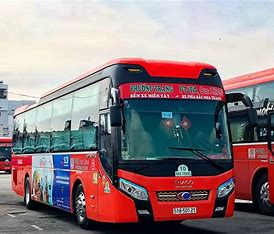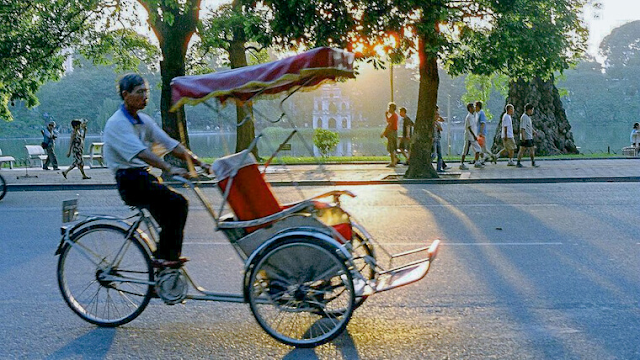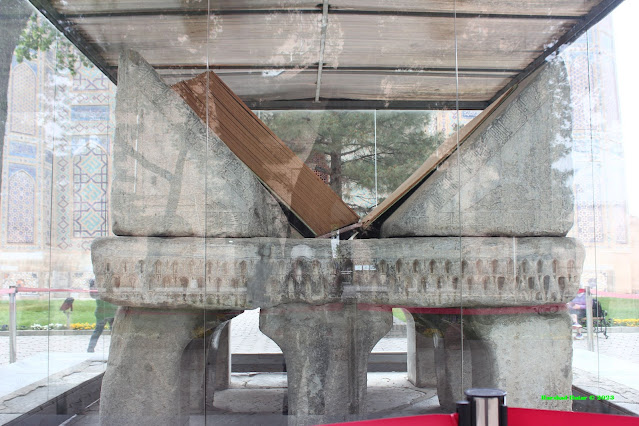Ho Chi Minh City
Ho Chi Minh City, fondly called HCMC by Vietnamese and formally known as Saigon, is situated inland on the navigable Saigon River. Since the Saigon River is navigable, HCMC has a functional port, that makes it a port city. It was the most populous city in Vietnam, was most populous because, during our recent visit, we were told that Hanoi had now taken over HCMC.
It is the most well-known face of Vietnam and it is a happening city. Our first blog, "Vietnam, General Information" covers the accommodation scene, food and local transport at HCMC and all other locations. You can read this blog here - Harshad: Vietnam - General Information (harshad-datar.blogspot.com).
HCMC is a very modern city yet it has a bloody history of the Vietnam War era. In fact, this war was over only after Saigon fell to the North Vietnamese forces. It therefore has some of the war-related places as tourist attractions.
Let us go on a virtual trip to HCMC. The images you see are copyrighted through my DSLR and Mobile lenses, except when specifically mentioned. If the image credit is not mine, I have given due credit to the original photographer or Internet, as the case may be. Ittakes two days to visit all these places. It goes without saying that at least two days are needed to visit HCMC. But we will travel together and finish this trip in one blog post😆😆.
Our virtual tour will take us to the following places-
Museum of War Remnants. Vietnam fought a prolonged and bloody war first with French forces and subsequently with America. There were many things, mostly bad and very very bad that happened during this war which lasted for 20 long years (1955 to 1975) and finally ended with the fall of Saigon (Now called Ho Chi Minh City) and the withdrawal of American forces.
There was an exhibition of some kind at the present location to showcase and document the war crimes of American forces since the war ended, however, it was in 1995 that this place was named War Remnants Museum. The present-day building construction started in 2002 and finished in 2010.
This museum is housed in a three-story building, with various displays on each floor, which are well-classified and exhibited. There are weapons, photos, AV rooms, displays of models, etc. Visiting this Museum leaves the visitors moved to the core by looking at what one human being can do to another. This visit may disturb a visitor for some time but we would still recommend visiting this place.
I did not have enough courage to photograph the human tragedies chronicled inside this museum. Only a few photos outside are posted below:-
 |
| Some War Trophies |
 |
| Some more |
Independence Palace. Independence Palace is a fairly recent building replacing an older building of the same name which got damaged in a bombing by some defecting Air Force pilots. The construction of this palace was started in 1962 by the then Head of state of South Vietnam. The Palace was completed in 1966 and inaugurated on 31 Oct 1966. from 1967 to 1975 it was the office and residence of the South Vietnam Head of State. This palace was a moot witness to the bloody Vietnam War.
The war effectively ended when a Tank numbered (See photo below) of the North Vietnamese Army entered the palace on 30 Apr 75.
There is a helicopter on the roof of this palace which symbolises an actual Helicopter of American forces which had landed to extricate the President of South Vietnam on 29 Apr 75.
There are also some areas of the roof which suffered minor damage due to a bombing raid just short of the end of the war.
The palace has various state rooms like a cabinet room, President's office, meeting room, etc, besides a war room in the basement. The premise also has the original tank of the Communist North Vietnam Army, which was instrumental in making the Vietnam War officially over (Actually very little was left of the war because the whole of Vietnam was already under North Vietnamese Army control except symbolic resistance by way of Independence place which was yet to be conquered).
This palace has a well-laid-out garden and one can have a commanding view of the garden and parts of Ho Chi Minh City from its rooftop
 |
| Independence Palace, Ho Chi Minh CIty |
 |
| This is THE North Vietnamese Tank that entered Independence Palace. Its appearance ended the war |
 |
| Cabinate room |
 |
| Conference Hall |
 |
| Escape Helicoptor (representative piece) meant to pick up President of South Vietnam. |
Central Post Office. Central Post Office is a colonial building built by the French between 1886 and 1891. Vietnam then was part of French Indochina. This building has a mix of Gothic, Renaissance and French influences which can be discerned when one visits here. On the outside wall of the building, there are memorials to the scientists and engineers who contributed to the advancement of Communication technology in those years.
It has an imposing hall housing the Post office counters and some souvenir shops. There are three old-time telephone booths on the right side almost at the entrance of this hall. There are two maps in the hall, one depicting the Saigon region and the other the telegraph lines in South Vietnam and Cambodia.
Today, this is more of a tourist place than a Post Office (though it exists and is operational). There is a tradition of writing and sending a postcard(s) from here with memories of Saigon.
Notre Dame Cathedral. After conquering Vietnam, French colonist built a community after their conquest. However, finding that church way too small, French Admiral Bonnard constructed this new and large church in two years starting in March 1863. The use of this church commenced in 1885. While the church was named Notre Dame Cathedral. it is popularly called Saigon Church.
This Cathedral is located centrally and has a square in front of it called Paris Square. This square is a very lively place frequented by tourists and locals. The streets around this Cathedral also are frequented by people for Cafes and bookshops.
Jade Emperor Temple. Built by a Chinese Businessman in the early 20th century, this centrally located Pagoda in Ho Chi Minh City is one of the well-known Pagoda.
.It is one of the most visited places of attraction in HCMC. It has seen 4 renovations from the time it was built. Jade Emperor is the most powerful of the Buddhist gods who heads and manages all the affairs in the Haven and Earth.
This pagoda is also revered by locals as the place which grants Fertility and hence often visited by couples desirous of having a child visit this place and seeking blessings.
Ben Thanh Market. Once upon a time in the 18th century, there was an informal market of street vendors along the Saigon River. In the 19th century, when the French colonised Vietnam, they created a formal market of these vendors by giving a proper marketplace to these vendors. After a few years, they were shifted to a proper market in central Saigon (present-day HCMC).
What is now famous as Ben Thanh Market was constructed in French style about a hundred years ago. this market has four entrances and is divided into 4 quadrangles, each assigned to a group of similar types of items like fruits and vegetables. Cloths and cosmetics, etc.
This market is one of the most visited places in Saigon. For Indian travellers, the only major drawback is, that this place shuts down at 7 PM. That means if an Indian tourist wants to visit this market (who are used to having markets open till 9 to 10 PM back home), they must tailor their programme in such a way that they get clear one hour to one hour and a half to visit this place if they want to explore all four section
Another interesting thing is, that when the formal market closes, an informal food and fruit market opens along the external streets of this main market.
 |
| Ben Thanh Marekt, Photo from Internet |
 |
| Inside View (Photo from Internet) |
Vinh Trang Pagoda. One of the best-known Pagoda in the Mekong Delta region, this 19th-century Pagoda is situated in the village of My Tho. This temple has seen destruction and rebuilding/renovations multiple times because it is situated within the most war-ravaged area of Vietnam from the time of Vietnam Vietnam-French War.
This temple has beautiful entry gates and an even more beautiful central building having the status of various Buddhas. The temple complex also has a massive statue of Bodai, a Chinese Buddhist Monk. The name actually refers to the loose cloth bag that he always carried. He is also called Laughing Buddha for his jolly nature.
This Pagoda is generally included in the itinerary of visitors along with the Mekong Delta.
.jpeg) |
| Vinh Trang Pagoda |
Mekong Delta and Tropical Fruit Garden. The Mekong River originates from Tibet, traverses through six nations, and meets the sea around Saigon aka Ho Chi Minh City. This river is the lifeline for all these countries. It helps these countries in producing the staple food of the countries, which are, growing Rice and Fishing.
Mekong Delta, in South Vietnam, has another distinction. Apart from growing rice and fisheries, this area has a large production of tropical fruits. There are a large number of fruit gardens in this area. This has made this area a tourist attraction. During a trip to the Mekong Delta, the boat ride through narrow waterways using traditional Sampan boats rowed mostly by Women, yes, Women and visiting the fruit garden and sampling some of the tropical fruits while enjoying traditional Vietnamese music are the main highlights.
 |
| Sampan, Traditional Vietnamese Boats in Mekong Delta |
 |
| Water Coconut Plant |
Cu Chi Tunnel. Vietnam at some point in time, after the French-Vietnam War, the expected unification did not happen and Vietnam got split into North Vietnam, a part of Vietnam governed by Communist and South Vietnam, the area under the control of Non-Communist forces. Soon a war erupted between North Vietnamese and South Vietnam forces. Originally, America took an advisory role to help South Vietnamese forces in this war but soon became a party to the war. With America joining the war, it became a war between North Vietnam Forces and the combined forces of America and South Vietnam.
American forces were defeated and finally, the fall of South Vietnam was sealed with the fall of Saigon is well-known history. What many did not understand then was how come a rag-tag force of the North Vietnamese Army could defeat the mighty American Army. There were many contributory factors to this win, but the most important contributor was an underground tunnel system spread across Vietnam and extensively used by Vietcong (North Vietnamese) fighters.
The most notable tunnel system was in Cu Chi area of HCMC. It had a full life support system and military utility areas. The tunnels had schools, hospitals, ammunition dumps, operational rooms, living quarters, etc. The tunnels were very difficult to live in and were infested with rodents, snakes and other insects but the North Vietnamese grit was obviously stronger than the odds. Two concentrated attempts by American forces to tackle these tunnels failed.
Today, the Vietnam government has preserved a relatively small section of about 71 km of these tunnels. A smaller section is what is open for the tourists to visit. Today these parts draw the biggest number of tourists. Tourists get to visit these tunnels, experience the life in these tunnels, see the booby trap systems, ventilation systems, etc.
 |
| Representation of Tunnels in Cu Chi (Image from Internate) |
 |
| Actual Tunnel |
If a visitor is fit enough to travel through these tunnels, whatever small sections are open, then Cu Chi tunnels are a must-visit destination in HCMC.
Eat Street in District One of HCMC. Street food is available all over HCMC and it is a must to try street food when visiting this city. The variety of Street Food and a number of stalls across this city (in every district) that many visitors call Saigon one gigantic open-air restaurant.
In the centre of Saigon, in District One, when Beh Thanh market closes at 7 pm, both sides of this market convert to Street Food markets. There is also a dedicated Ben Thanh Street Food Market (called Ben Nghe Street Food Market), just six hundred meters from Ben Thanh Market.
This place boasts of about 25 to 30 stalls of a variety of Street foods. Amongst many such stalls and places, we recommend this, because we have visited this place, found it good and hygienic and hence the recommendations. If you are at Independence Palace or Ben Thanh Market and it's around lunch or dinner time, you can safely visit this place,
 |
| Ben Thanh Street Food Market (Image from Internet) |
 |
| Inside view (Image from Internet) |
Wrap Up. The above blog post is a curtain raiser for travellers. Ho Chi Minh City aka Saigon is an immersive place. This place has something for every traveller, from History, Culture, Food, Nightlife and much more. One blog post can not do full justice to the beauty of Vietnam, a charming big city with a mix of Vietnamese and French charm. If one is visiting Vietnam, HCMC is a MUST destination.
Our recommendation, HCMC, यह नही देखा तो क्या देखा, If you have not seen HCMC, you haven't seen anything.






























.jpeg)

.jpeg)















































